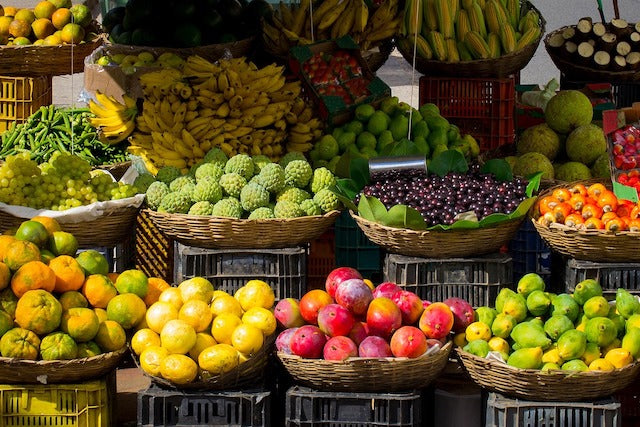Yes. All chameleon species can eat fruits and vegetables. But before you head to your fridge to grab an apple to chop into tiny little pieces for your pet chameleon, know that feeding fruits and vegetables to your chameleon is completely optional.
Can Chameleons Eat Fruits and Vegetables?
Chameleons are primarily insectivores. Even in the wild, their primary food consists of whatever insects they find within range of their lightning-quick tongues.
For the majority of tree-dwelling species, this means the flies, locusts, and various types of worms that make their way up into the chameleon’s arboreal home. For some of the smaller species, this means snatching up whatever they find crawling along the ground.
However, it’s not uncommon for chameleon keepers – especially Veiled Chameleon keepers – to catch their chameleon snatching bites of the live vegetation within its enclosure.
Why is this?
There are two primary reasons that chameleons in the wild eat fruits, vegetables, and vegetation:
- Hydration
- Supplementation
Hydration
In a chameleon’s wild habitat, water is not a guarantee. Rain often comes at inconsistent intervals, and there’s no telling when a dry spell might strike.
Although chameleons’ primary source of water is the droplets they find trickling down the leaves and plant life of their natural habitats, chameleons will often eat the local vegetation to supplement their hydration when their preferred water droplets are not readily available.
This is especially true of fruits, which otherwise offer almost no nutritional benefit to chameleons.
Supplementation
When it comes to nutrition, it’s important to keep in mind that wild insects aren’t intentionally gut-loaded with highly nutritious foods. When a chameleon eats insects in the wild, it’s not always getting the vitamins and minerals it needs to survive and remain healthy. They’ll self-supplement their diet, therefore, by eating the local vegetation.
On a similar note, as arboreal creatures, the vast majority of chameleon species are very limited in their options of high-chitin foods. For the most part, they’re eating the low-chitin flying insects and worms that make their way into the rainforest treetops.
Wild chameleons need a little extra roughage to help the digestive process, and so they’ll eat some of the local plantlife surrounding them.

Why Should You Feed Your Chameleon Fruits and Vegetables?
When it comes to offering fruits and vegetables to your pet chameleon, the truth is that you don’t need to. So why do so many chameleon keepers think it’s essential for them to supplement their pet chameleon’s diet with fruits and vegetables?
The confusion is largely due to three influences:
- It often shows up on chameleon care sheets from pet stores.
- Many influencers in chameleon care claim that chameleons need to eat fruits and vegetables to have a healthy diet.
- There are lots of videos showing chameleon keepers feeding fruits and vegetables to their chameleon.
When it comes to offering your pet chameleon a properly balanced diet, the best thing you can do for it is provide a wide variety of gut-loaded insects.
When you properly gut-load your feeder insects, your pet chameleon will absorb the vitamins, minerals, and nutrients that you’ve given the insect prior to feeding. Additionally, when you follow a strict supplemental regimen of calcium without D3, calcium with D3, and multivitamins, your chameleon will get all the nutrients it needs.
Plus, when your primary feeder insects include crickets, Dubia roaches, and other high-chitin insects, your chameleon no longer needs the extra roughage to aid digestion.
What Fruits Can Chameleons Eat?
After all of the above, maybe you still want to offer your pet chameleon some fruit and vegetables. After all, those videos of Veiled Chameleons chomping on a hunk of papaya or trying to navigate a collard leaf can be awfully cute.
So, what fruits are safe for your chameleon to eat, and what fruits should you avoid? Fruits that are safe for your chameleon include:
- Apples
- Peaches
- Blueberries
- Mango
- Cantaloupe
- Pears
- Melon
- Grapes
These fruits are safe if you follow these rules: cut them to the right size (follow the same rule of thumb as you follow for the size of your feeder insects), only offer them as occasional treats, and you remove the core and the seeds.

Fruits you should avoid include:
- All citrus
- Strawberries
- Apricot
- Bananas
While these may not be immediately detrimental to your chameleon’s health, they may cause some problems over time. For example, fruits that are high in phosphorus – like citrus and bananas – can actually interfere with your chameleon’s calcium absorption.
Overfeeding fruit or offering it at the wrong time can lead to other health problems like malnutrition or Metabolic Bone Disease (MBD). Plus, your chameleon’s digestive tract isn’t designed to digest the sugars in fruit.
Pro Tip: Only offer fruit pieces on days that you’re not also offering feeder insects. If you offer fruit immediately before offering feeder insects, your chameleon’s belly will be full, and it may refuse its more nutritious meal.
The bottom line is, there’s really no nutritional value to offering fruit to your pet chameleon. Chameleons will typically only eat fruit to supplement their hydration. As long as your chameleon’s enclosure is equipped with a good misting and dripping system, you shouldn’t need to supplement its hydration at all.
What Vegetables Can Chameleons Eat?
As with fruit, there are some vegetables that are safe for your chameleon to eat, and some that you should avoid. Safe vegetables include:
- Collards
- Dandelion
- Kale
- Romaine Lettuce
- Mustard Greens
- Endive
- Carrots
- Squash
- Zucchini
Vegetables to avoid include:
- Avocados
- Iceberg lettuce
- Broccoli
- Cauliflower
- Tomatoes
- Cabbage
- Spinach
- Sweet Potato
- Peppers
Warning: Vegetables in the nightshade family – sweet potatoes, peppers, tomatoes – are actually toxic for chameleons and can make them sick.
Will your chameleon get some nutritional value out of the vegetables that are safe for them to eat? Sure. But there’s a two-fold problem you’ll face here.
First: Your chameleon is highly unlikely to actually eat whatever vegetables you offer. With the exception of Veiled Chameleons, the chameleon species kept as pets just won’t eat any sort of vegetation. They don’t like it. This is especially true of Panther Chameleons, who tend to be much more predatory in their habits.
Second: You’re creating unnecessary work for yourself. If you’re properly gut-loading your feeder insects 12 hours prior to feeding, your chameleon will be getting all the nutrients from the vegetables you feed your insects.
The best thing you can do for your chameleon is gut-load your feeder insects with the above mentioned safe vegetables, then follow a strict regimen of calcium and multivitamin supplements.
Takeaway: Can chameleons eat fruits and vegetables? Yes. They can. But when it comes to pet chameleons, the real question is whether or not they need to. If you’re properly gut-loading your feeder insects, following a strict supplemental regimen, and making sure your chameleon’s enclosure is equipped with a good misting and dripping system, then there’s no need to offer fruits or vegetables to your pet chameleon.
If you have questions or would like to give feedback, please email us at team@dragonsdiet.com








